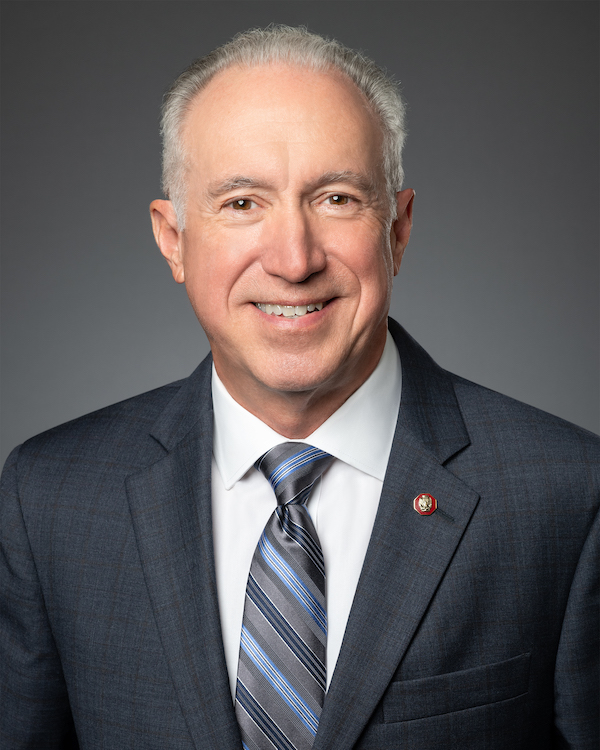
AIA|LA DESIGN PROFESSIONALS IN ACTION:
Questions for Peter Devereaux FAIA, LEED AP – Founding Principal, HED & Chair of the Board, Innovation Design Consortium
Spark & Vision: Describe a formative experience that ignited your passion for architecture and how it shaped your vision for impacting the built environment.
I loved to draw and to build models as a child and when I learned that I could get paid to do that as an architect, I was hooked. I was the first person from either side of my family to go to college and I really didn’t know what to expect. In 1974, my first year at Penn State, we took a field trip to see Falling Water, the spectacular residence designed by Frank Lloyd Wright. Up until then, I saw architecture as a vocation, but I was blown away by the experience of walking through and around that beautiful home. That was when I realized that great architecture creates functional environments for living and working while also creating inspirational visual impact. That was the day my passion for design was ignited.
Values in Design: Beyond aesthetics, what core values guide your design process? How do you translate those values into projects that leave a lasting positive impact on communities?
My values were shaped most strongly while I was studying at Yale when Cesar Pelli was the Dean of the School of Architecture and later when I worked in his office in New Haven. One area of focus for me while at Yale was the concept of “Authenticity”, in fact, as co-editor of the Yale Architecture Journal, Perspecta 20, that became a theme for the issue. This should be viewed in the context of it occurring during the height of the Post-Modern movement when the application of witty historical pastiche was ruling the day. We were looking back to the modern masters (like Wright at Falling Waters) who knew how to use materials and craftsmanship to create something timeless in its beauty. Working in Cesar’s office, I learned the importance of collaborating with a team of engineers to design a building efficiently, and cost-effectively, and to focus design energy judiciously on specific building elements to fit within the budget.
Technology and Architecture:
The design industry hasn’t changed very much in the last couple of hundred years. Over that period Architects have been leading teams that produce drawings used to build buildings. Although those buildings have become exponentially more complex constructions and the teams have become larger this process has remained very much unchanged. I do believe, however, that we are on the cusp of a transformational period that will greatly impact the profession. We have been talking about this at the AIA Large Firm Round Table CEO meetings for several years now, and I credit Bob Packard, the former CEO of Zimmer Gunsul Frasca for kicking off that conversation when he asked, “What is out there that will do to architects what Uber did to the taxi drivers?”
That concern is justified, as the design and construction industry, having changed so little and not embraced technology, is highly inefficient. That is why private equity is pumping vast sums of money into our space on the bet that they can disrupt the status quo. The CEOs of large firms have spent hours discussing how we can remain relevant in that changing landscape, which ultimately led to the formation of the Innovation Design Consortium. In January of 2023, backed by the financial support of forty of the largest US design firms the IDC, a public benefit corporation, was established to advance the use of technology in the design space.
Because I played a central role in the conversation while serving on the Executive Committee of the AIA LFRT for six years, and as the liaison between the CEO Group and the CIO Group, I was elected to Chair the IDC’s Board of Directors. One reason our industry has been a technology laggard is because it is so fragmented. Even the largest design firm has less than 1% of the market share, and that fact challenges our ability to invest effectively in transformational R&D efforts. By pooling the resources of forty firms, we can now do things that alone, no firm would attempt. We expect to open membership to the consortium on a subscription basis to all firms later this year. Our hope is that we can harness technology to keep architects relevant in a rapidly changing business environment.
###
To learn more about the Innovation Design Consortium PLEASE CLICK HERE.
Peter Devereaux FAIA, LEED AP – Founding Principal, HED & Chair of the Board, Innovation Design Consortium
Peter Devereaux was born in Allentown, Pennsylvania and received a BS in Architecture from Penn State University and a Master of Architecture from Yale University. Cesar Pelli was Dean of the Yale School of Architecture at that time and hired Peter to work for him upon graduation. In 1985, Devereaux left Pelli’s office in New Haven, CT to take a design leader role with a nine-person firm in Los Angeles where he eventually became a Principal.
Under Peter’s leadership as CEO, that small firm, Fields Devereaux, grew to a staff of 175 people and expanded into three cities in California. In 2006, Fields Devereaux merged with HarleyEllis, a Michigan-based corporation established in 1908, to form Harley Ellis Devereaux, an integrated practice of architects, engineers, and planners. Today HED has 450 employees in ten locations.
Peter was elevated to the College of Fellows of the American Institute of Architects in 2006 and served as a member of the Executive Committee of AIA’s Large Firm Roundtable from 2015 through 2021. In 2023 he was elected Chairman of the Board of the Innovation Design Consortium, a public benefit corporation formed by forty of the largest design firms in the country to advance the utilization of technology within the design space.







